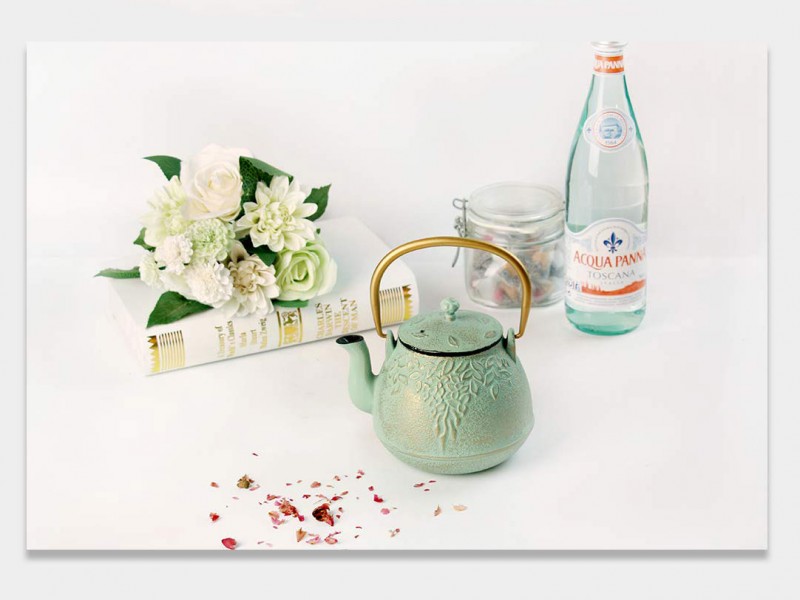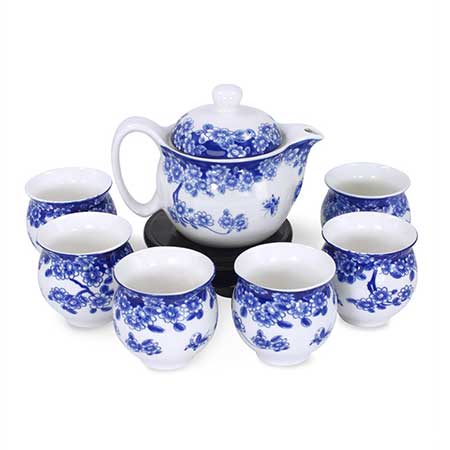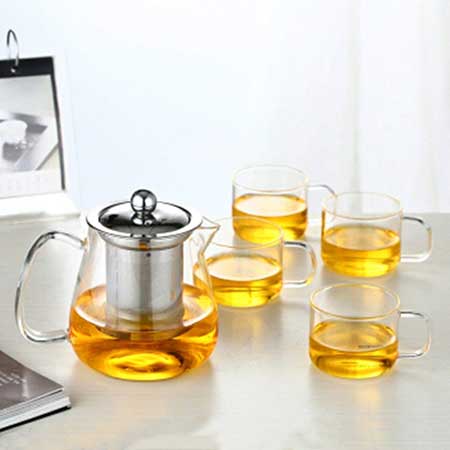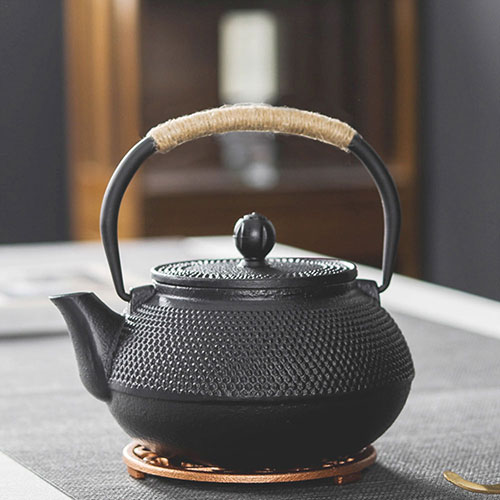5 Reasons to Use a Cast Iron Teapot

5 Reasons to Use a Cast Iron Teapot
Awhile back I unabashedly waxed rhapsodic about my little cast iron teapot from Japan. Others before and since have done the same. So, just what is so special about these teapots that they would inspire such a reaction from their users? I found five reasons. You may have more.
1 Appearance
Designed as much for their visual appeal as for their practicality, cast iron teapots are a graceful ornament to your décor. In Japan, cast iron teapot designs have evolved to be quite intricate with different shades and colors and various decorative elements, as well as a variety of shapes, including some that are rectangular. Some design elements include cherry blossoms, dragonflies, elephants, bamboo, koi, and dragons. There is also what I call the “bump” design where the exterior is covered with uniform little bumps (that’s the kind I have).
2 Heat and Steep
Unlike most teapots, cast iron teapots can be set directly on your stove or even an open flame. Some guidelines to follow:
It’s best to have some liquid in the teapot before setting it on the heat source.
When using a gas stove or setting on an open flame, keep the flames low so they do not hit the sides of the teapot.
Fill the teapot about two thirds full of water so that when it boils it does not bubble over.
Add the tea leaves in after the water is heated (not a strict rule, just my personal experience here — you can always try added the tea leaves into the water first and then heating).
If you use the infuser basket that often comes with these teapots, put it in after heating the water. (Also, the rim will get very hot during steeping, so take care when lifting it out.)
These teapots can absorb some of the flavors of the teas you steep in them (not quite as readily a zisha clay teapots), so you may want to designate different teapots for different teas and “season” them by doing several steepings close together.
3 Durability
If you’ve ever had one of those “Oops!” moments, no explanation is needed here. We all probably have at least one ceramic, bone china, terracotta, stoneware, glass, or zisha clay teapot that is chipped or missing a spout, handle, or lid. A cast iron teapot could survive just about anything you do to it except throwing it in a smelting furnace — or an erupting volcano.
Pig iron forms the basis for cast iron. While it is being melted, scrap iron and steel are often thrown into the mix. Impurities such as sulfur are subtracted, leaving an end product that is about 95% iron and various percentages of carbon, silicon, and traces of other elements. The metal is more brittle and malleable than pure iron and steel, making it ideal for creating intricate shapes such as these teapots.
Cast iron teapots are not too heavy and wash up easily with warm water and a mild, unscented soap. You should be sure to dry them thoroughly after washing.
4 Tradition
Japanese cast iron teapots (also known as “tetsubin”) bring to mind centuries past. Cast iron teapots have been used in Japan as early as the 1600s. They became popular with the rise in steeping tea leaves instead of matcha tea powder. When you use one of these teapots, you are in essence carrying on a tradition of tea steeping that focuses on a full appreciation of every aspect of enjoying tea.
5 Atmosphere
It is not just the stunning visual of a cast iron teapot that appeals, but also the atmosphere created when using one. You have to slow down and take a little more time. You have to pay a little more attention to the tea steeping process. And the pouring of the steeped tea is in itself a small ceremony done with care and patience. (And you definitely don’t want to giggle while you pour!)
See more of Teaware articles here.



9 Comment(s)
Các chương trình khuyến mãi của họ rất dễ dàng tham gia và thường xuyên có phần thưởng hấp dẫn.\r\nTôi cảm thấy rất hài lòng về dịch vụ khách hàng của FB88, họ luôn giúp tôi giải quyết vấn đề rất nhanh chóng.\r\nTôi luôn cảm thấy hài lòng với trải nghiệm chơi game trên FB88.
Tôi luôn cảm thấy hài lòng với trải nghiệm chơi game trên FB88.\r\nTôi thấy cược thể thao trên FB88 rất chuyên nghiệp, tỷ lệ cược rất cạnh tranh.\r\nTôi rất thích trải nghiệm các trò chơi slot tại FB88, phần thưởng rất lớn và hấp dẫn.
Trường Tiểu học Nguyễn Trung Trực được thành lập năm 1985 có địa chỉ tại 9A Phạm Hồng Thái, phường Nguyễn Trung Trực, quận Ba Đình, Hà Nội (Nay thành phường Trúc Bạch). Trường hoạt động dưới sự quản lý của UBND quận Ba Đình và Phòng Giáo dục và Đào tạo Ba Đình. Trường được xây dựng khang trang trên diện tích hơn 3000 m2 với đủ các phòng học và phòng chức năng cho các hoạt động học tập, vui chơi, giải trí của học sinh.\r\nĐịa chỉ: Số 9A Phạm Hồng Thái - Ba Đình - Hà Nội\r\nEmail: [email protected]\r\nwebsite: https://c1nguyentrungtruc.badinh.edu.vn/\r\nĐiện thoại: 438261441
Trường Tiểu học Nguyễn Trung Trực được thành lập năm 1985 có địa chỉ tại 9A Phạm Hồng Thái, phường Nguyễn Trung Trực, quận Ba Đình, Hà Nội (Nay thành phường Trúc Bạch). Trường hoạt động dưới sự quản lý của UBND quận Ba Đình và Phòng Giáo dục và Đào tạo Ba Đình. Trường được xây dựng khang trang trên diện tích hơn 3000 m2 với đủ các phòng học và phòng chức năng cho các hoạt động học tập, vui chơi, giải trí của học sinh.\r\nĐịa chỉ: Số 9A Phạm Hồng Thái - Ba Đình - Hà Nội\r\nEmail: [email protected]\r\nwebsite: Https://kumu.io/NhacaiFB88betB88S/nhacaifb88betb88s#nhacaifb88betb88s\r\nĐiện thoại: 438261441
Trường Tiểu học Nguyễn Trung Trực được thành lập năm 1985 có địa chỉ tại 9A Phạm Hồng Thái, phường Nguyễn Trung Trực, quận Ba Đình, Hà Nội (Nay thành phường Trúc Bạch). Trường hoạt động dưới sự quản lý của UBND quận Ba Đình và Phòng Giáo dục và Đào tạo Ba Đình. Trường được xây dựng khang trang trên diện tích hơn 3000 m2 với đủ các phòng học và phòng chức năng cho các hoạt động học tập, vui chơi, giải trí của học sinh.\r\nĐịa chỉ: Số 9A Phạm Hồng Thái - Ba Đình - Hà Nội\r\nEmail: [email protected]\r\nwebsite: Https://kumu.io/NhacaiFB88betB88S/nhacaifb88betb88s#nhacaifb88betb88s\r\nĐiện thoại: 438261441
Trường Tiểu học Nguyễn Trung Trực được thành lập năm 1985 có địa chỉ tại 9A Phạm Hồng Thái, phường Nguyễn Trung Trực, quận Ba Đình, Hà Nội (Nay thành phường Trúc Bạch). Trường hoạt động dưới sự quản lý của UBND quận Ba Đình và Phòng Giáo dục và Đào tạo Ba Đình. Trường được xây dựng khang trang trên diện tích hơn 3000 m2 với đủ các phòng học và phòng chức năng cho các hoạt động học tập, vui chơi, giải trí của học sinh.\r\nĐịa chỉ: Số 9A Phạm Hồng Thái - Ba Đình - Hà Nội\r\nEmail: [email protected]\r\nwebsite: Https://s666s666s.com/\r\nĐiện thoại: 438261441
Trường Tiểu học Nguyễn Trung Trực được thành lập năm 1985 có địa chỉ tại 9A Phạm Hồng Thái, phường Nguyễn Trung Trực, quận Ba Đình, Hà Nội (Nay thành phường Trúc Bạch). Trường hoạt động dưới sự quản lý của UBND quận Ba Đình và Phòng Giáo dục và Đào tạo Ba Đình. Trường được xây dựng khang trang trên diện tích hơn 3000 m2 với đủ các phòng học và phòng chức năng cho các hoạt động học tập, vui chơi, giải trí của học sinh.\r\nĐịa chỉ: Số 9A Phạm Hồng Thái - Ba Đình - Hà Nội\r\nEmail: [email protected]\r\nwebsite: Https://s666s666s.com/\r\nĐiện thoại: 438261441
Trường Tiểu học Nguyễn Trung Trực được thành lập năm 1985 có địa chỉ tại 9A Phạm Hồng Thái, phường Nguyễn Trung Trực, quận Ba Đình, Hà Nội (Nay thành phường Trúc Bạch). Trường hoạt động dưới sự quản lý của UBND quận Ba Đình và Phòng Giáo dục và Đào tạo Ba Đình. Trường được xây dựng khang trang trên diện tích hơn 3000 m2 với đủ các phòng học và phòng chức năng cho các hoạt động học tập, vui chơi, giải trí của học sinh.\r\nĐịa chỉ: Số 9A Phạm Hồng Thái - Ba Đình - Hà Nội\r\nEmail: [email protected]\r\nwebsite: Https://s666s666s.com/\r\nĐiện thoại: 438261441
Trường Tiểu học Nguyễn Trung Trực được thành lập năm 1985 có địa chỉ tại 9A Phạm Hồng Thái, phường Nguyễn Trung Trực, quận Ba Đình, Hà Nội (Nay thành phường Trúc Bạch). Trường hoạt động dưới sự quản lý của UBND quận Ba Đình và Phòng Giáo dục và Đào tạo Ba Đình. Trường được xây dựng khang trang trên diện tích hơn 3000 m2 với đủ các phòng học và phòng chức năng cho các hoạt động học tập, vui chơi, giải trí của học sinh.\r\nĐịa chỉ: Số 9A Phạm Hồng Thái - Ba Đình - Hà Nội\r\nEmail: [email protected]\r\nwebsite: Https://s666s666s.com/\r\nĐiện thoại: 438261441
Leave a Comment